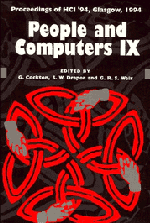Book contents
- Frontmatter
- Contents
- Preface: HCI'94 – You Probably Haven't Seen It All Before
- Part I Invited Papers
- Part II Methodology of Interactive Systems Development
- 3 Transferring HCI Modelling and Design Techniques to Practitioners: A Framework and Empirical Work
- 4 The Use of Visual Indexing as an Interview Support Technique
- 5 A Domain Analysis of Air Traffic Management Work can be Used to Rationalise Interface Design Issues
- 6 Manuals as Structured Programs
- 7 Improving Education through Computer-Based Alternative Assessment Methods
- 8 Visual Programming in a Visual Domain: A Case Study of Cognitive Dimensions
- 9 Evaluating Evaluation Methods
- Crafting Interaction: Styles, Metaphors, Modalities and Agents
- Modelling Humans, Computers and their Interaction
- Notations and Tools for Design
- Part VI Computer-Supported Cooperative Work
- Author Index
- Keyword Index
3 - Transferring HCI Modelling and Design Techniques to Practitioners: A Framework and Empirical Work
Published online by Cambridge University Press: 04 August 2010
- Frontmatter
- Contents
- Preface: HCI'94 – You Probably Haven't Seen It All Before
- Part I Invited Papers
- Part II Methodology of Interactive Systems Development
- 3 Transferring HCI Modelling and Design Techniques to Practitioners: A Framework and Empirical Work
- 4 The Use of Visual Indexing as an Interview Support Technique
- 5 A Domain Analysis of Air Traffic Management Work can be Used to Rationalise Interface Design Issues
- 6 Manuals as Structured Programs
- 7 Improving Education through Computer-Based Alternative Assessment Methods
- 8 Visual Programming in a Visual Domain: A Case Study of Cognitive Dimensions
- 9 Evaluating Evaluation Methods
- Crafting Interaction: Styles, Metaphors, Modalities and Agents
- Modelling Humans, Computers and their Interaction
- Notations and Tools for Design
- Part VI Computer-Supported Cooperative Work
- Author Index
- Keyword Index
Summary
The human-computer interaction (HCI) community is generating a large number of analytic approaches such as models of user cognition and user-centred design representations. However, their successful uptake by practitioners depends on how easily they can be understood, and how usable and useful they are. We present a framework which identifies four different ‘gulfs’ between HCI modelling and design techniques and their intended users. These gulfs are potential opportunities to support designers if techniques can be encapsulated in appropriate forms. Use of the gulfs framework is illustrated in relation to three very different strands of work:
i. representing HCI design spaces and design rationale;
ii. modelling user cognition; and
iii. modelling interactive system behaviour.
We summarise what is currently known about these gulfs, report empirical investigations showing how these gulfs can be ‘bridged’, and describe plans for further investigations. We conclude that it is desirable for practitioners' requirements to shape analytic approaches much earlier in their development than has been the case to date. The work reported in this paper illustrates some of the techniques which can be recruited to this end.
Keywords: theory-based design, evaluation, design rationale, cognitive modelling, formal specification.
Introduction
The human-computer interaction (HCI) community is generating a large number of analytic, usability-oriented approaches such as cognitive modelling and user-centred design representations. Three critical factors which will determine whether any of these approaches makes any impact on design practice are their intelligibility to practitioners, and their utility and usability.
- Type
- Chapter
- Information
- People and Computers , pp. 21 - 36Publisher: Cambridge University PressPrint publication year: 1994
- 1
- Cited by



